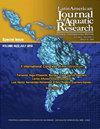Preliminary analysis of microplastics from the main continental nesting beach of the hawksbill sea turtle (Eretmochelys imbricata) in Venezuela
IF 0.8
4区 农林科学
Q3 FISHERIES
Latin American Journal of Aquatic Research
Pub Date : 2023-02-28
DOI:10.3856/vol51-issue1-fulltext-2789
引用次数: 0
Abstract
Microplastics are an increasing threat to marine fauna and oceanic habitats, potentially affecting sea turtle nesting beaches. Hawksbill sea turtles (Eretmochelys imbricata) are a Critically Endangered species with decreasing population trends. There are several hawksbill rookeries in the southern Caribbean Sea, particularly on Los Garzos Beach, the main nesting site of continental Venezuela. A preliminary physical analysis of microplastics sampled from 10 sites on Los Garzos Beach reported high numbers (94 ± 2.5 items) of 14 different materials and colors. Microplastic counts at 10 sites averaged 1504 ± 405.61 items m-2, higher than other sea turtle nesting sites worldwide. There were no statistical differences in the concentration of microplastics at the sampled sites of Los Garzos Beach. However, the concentration of microplastics on this beach is higher at the midpoint of the falling tide (3520 ± 405.61 items m-2) and the top of the sea turtle nesting area (3840 ± 405.61 items m-2). We speculate that this debris could harm the nesting environment of hawksbill sea turtles in the region. While this study presents preliminary values for microplastics in an important hawksbill turtle nesting beach in Venezuela, it also serves as a baseline for long-term studies that can help determine the impact and sources of plastic pollution in sea turtle rookeries.委内瑞拉玳瑁海龟(Eretmochelys imbricata)主要大陆筑巢海滩上的微塑料初步分析
微塑料对海洋动物和海洋栖息地的威胁越来越大,可能会影响海龟筑巢的海滩。玳瑁海龟(Eretmochelys brbricata)是一种极危物种,种群数量呈下降趋势。在加勒比海南部有几个玳瑁的繁殖地,特别是在委内瑞拉大陆的主要筑巢地Los Garzos海滩。从洛斯加尔索斯海滩的10个地点取样的微塑料的初步物理分析报告了14种不同材料和颜色的高数量(94±2.5项)。10个地点的微塑料计数平均为1504±405.61项m-2,高于全球其他海龟筑巢地。在洛斯加索斯海滩取样点的微塑料浓度没有统计学差异。而在退潮中点(3520±405.61项m-2)和海龟产卵区顶部(3840±405.61项m-2),微塑料浓度较高。我们推测这些碎片可能会破坏该地区玳瑁海龟的筑巢环境。虽然这项研究为委内瑞拉一个重要的玳瑁筑巢海滩提供了微塑料的初步值,但它也可以作为长期研究的基线,帮助确定塑料污染对海龟栖息地的影响和来源。
本文章由计算机程序翻译,如有差异,请以英文原文为准。
求助全文
约1分钟内获得全文
求助全文
来源期刊

Latin American Journal of Aquatic Research
FISHERIES-MARINE & FRESHWATER BIOLOGY
CiteScore
1.70
自引率
10.00%
发文量
44
审稿时长
4-8 weeks
期刊介绍:
Latin American Journal of Aquatic Research- LAJAR is the continuation of the journal Investigaciones Marinas (1970-2007) and is published since 2008 by the Escuela de Ciencias del Mar, Facultad de Ciencias del Mar y Geografía of the Pontificia Universidad Católica de Valparaíso. LAJAR is an “Open Access” journal that publishes in English language, original research articles, reviews and short communications on aquatic science, which contain the results of research conducted in aquaculture or in oceanic and coastal marine waters of Latin America.
The following topics are considered: Physical Oceanography, Chemical Oceanography, Marine Biogeochemistry, Marine Pollution and Toxicology, Marine Geology and Geophysics, Biological Oceanography, Fisheries and Aquaculture.
 求助内容:
求助内容: 应助结果提醒方式:
应助结果提醒方式:


